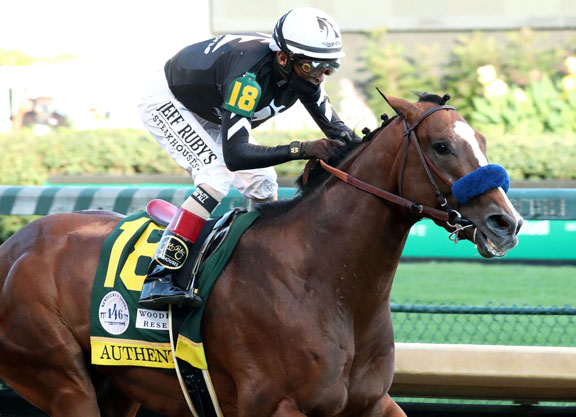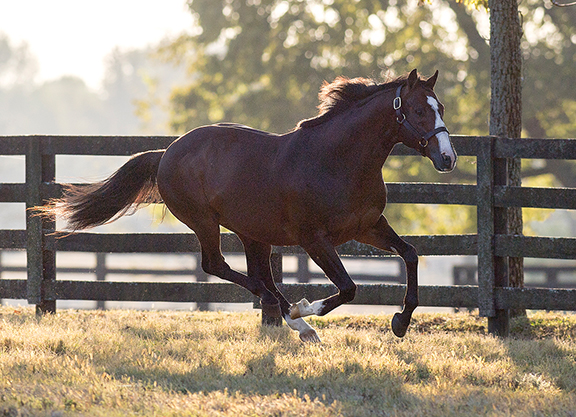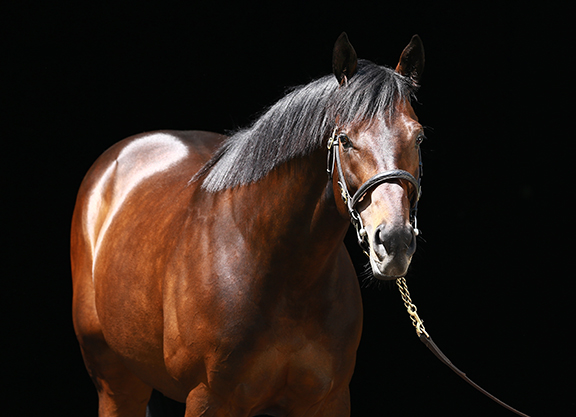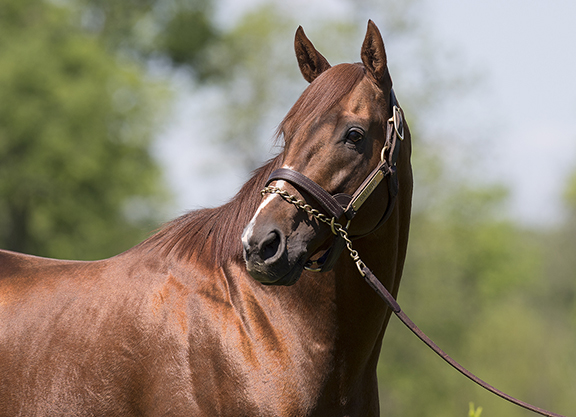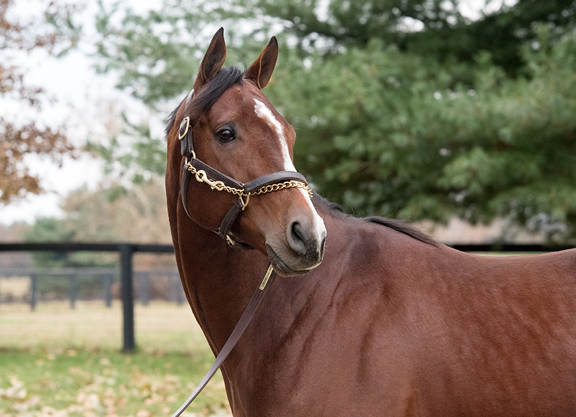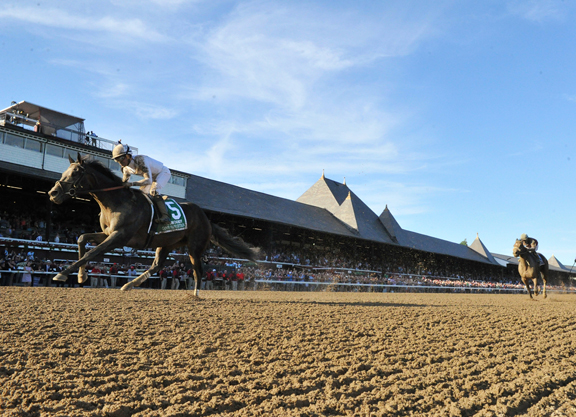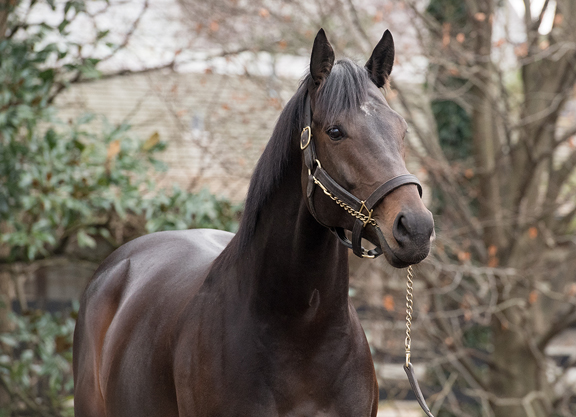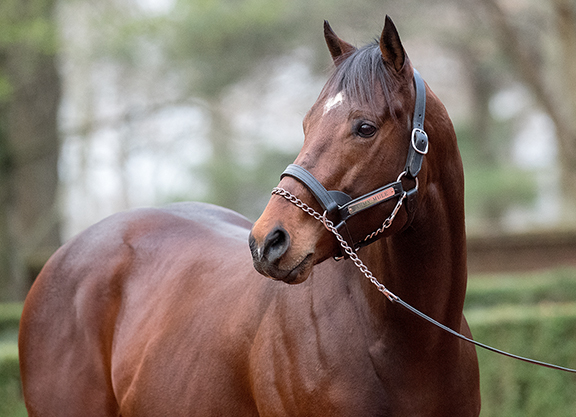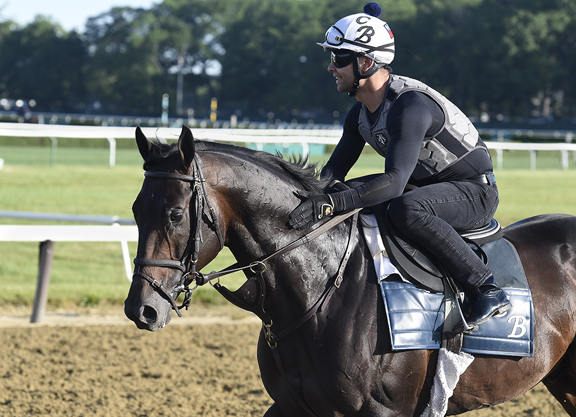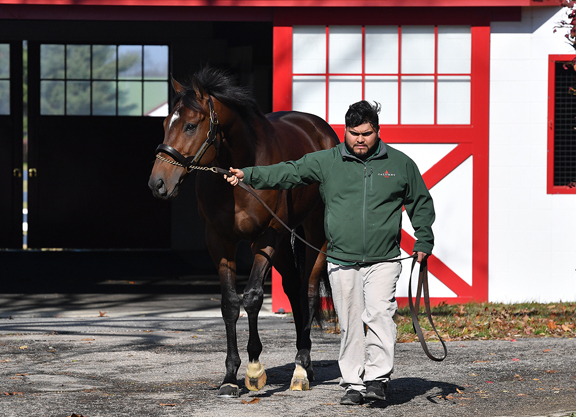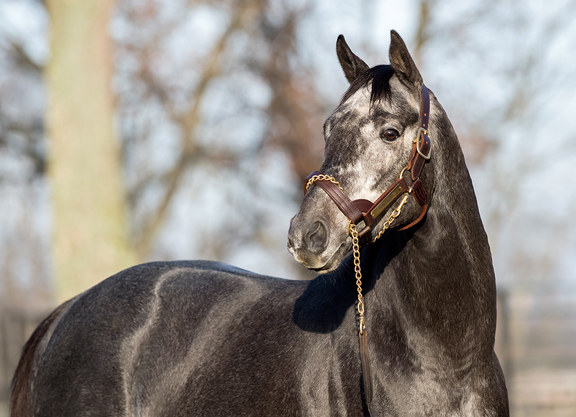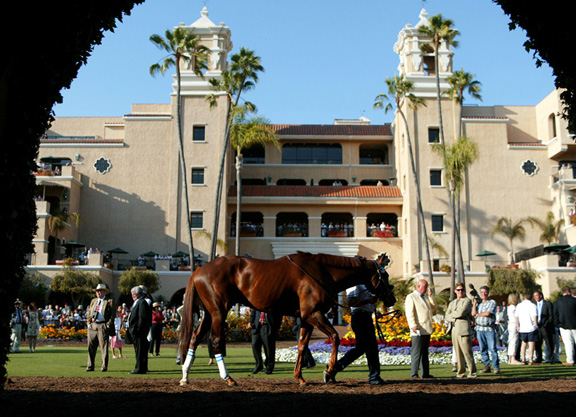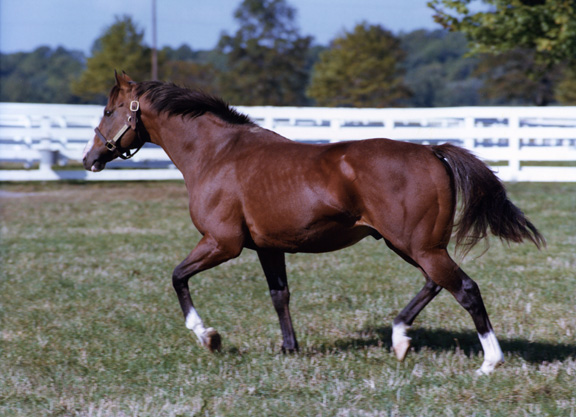Call it the year of authentication. After sealing his giddy rise with a first sires’ championship last year, Into Mischief has retained his title in 2020 with spectacular ease. Indeed, while several of his predecessors have required a single outstanding earner to elevate them above their rivals, this most remarkable of stallions would have secured the laurels even without the $7.17 million banked by a son on the point of formal anointment as Horse of the Year.
As it is, we can instead treat his latest champion, Authentic, as immediate and priceless confirmation that an upgrade in Into Mischief’s mares–and remember he was still only a $45,000 cover when Peter Blum sent Flawless (Mr Greeley) to the Spendthrift phenomenon in 2016–would enable him to draw out his trademark speed through a second turn.
There had, admittedly, already been auspicious glimpses of this capacity: Owendale and Audible, for instance, had both emerged from much cheaper books to finish strongly for Classic placings. But the emergence of a GI Kentucky Derby and GI Breeders’ Cup Classic winner is not a matter of mere consolidation for Into Mischief. Authentic represents a neon validation of his competence to produce the kind of Triple Crown stock commensurate with a fee that has now soared, even as tariffs are being slashed at his own and virtually every other farm, to $225,000.
And if Authentic proved to be aptly named, then how about Life Is Good as a potential flagship for their sire’s next crop, which was conceived at $75,000? It’s obviously early days for a colt who only made his debut last month, but their trainer is eyeing the GIII Sham S. on Saturday–the very race he used to launch Authentic as a similarly raw sophomore prospect.
Other Into Mischief youngsters already astir include Mandaloun, who has won both starts to date for Brad Cox and may head to the GIII Lecomte S. a couple of weeks later; and Highly Motivated, whose track record at Keeneland was admittedly one of several to fall Breeders’ Cup weekend but nonetheless attests to his abundant natural speed. As a sprinter who must show how far he can stretch, Highly Motivated sets a familiar challenge. But Mandaloun certainly measures the changing complexion of the genetic material nowadays complementing Into Mischief’s own contribution: he is a Juddmonte homebred, out of an Empire Maker mare who won a Group race over just short of 10 furlongs in Ireland.
The momentum behind Into Mischief, as such, looks inexorable for the next few years. His rise has been sustained by unusually reliable libido and fertility, and he remains assured of undiminished quantity to support the improving quality of his mares. His books have proved invulnerable to fee increases: his 2021 juveniles, conceived at $100,000, emerge from a book of 245; the next crop, at $150,000, from one of 241; and this year he covered 248 mares at $175,000. Obviously he has his home herd to service, gratis, but the turnover being generated by outside mares is still eye-watering.
Famously, of course, there are nine breeders out there who wouldn’t have to pay a cent–though presumably they will mostly have cashed out by now, having secured a lifetime breeding right by committing a mare to Into Mischief’s first two seasons. It was launching a couple of rookies into the backdraft of the 2008 financial crisis that inspired Spendthrift’s owner B. Wayne Hughes to develop Share the Upside, pioneer among many the incentive schemes that have meanwhile transformed the stallion industry in the Bluegrass. (A process, admittedly, that has discomfited many a farm; and, in candour, made some rivals resent the rise of Into Mischief as poster boy for a whole new culture.)
The kind of elite stallion Hughes is now managing to bring to the farm won’t need that kind of extra support. Both Spendthrift and its flagship stallion have come a long way since Into Mischief covered 50 mares at $7,500 in 2012, just as his first runners were about to reach the track.
Those first years earning his stripes do mean that Into Mischief is now in his prime, about to turn 16. He already has some promising sons at stud, even from his cheaper books, and breeders at all levels duly have more accessible alternatives: from those who sent 196 mares to Maximus Mischief at $7,500 in his debut book, to those who will pay 10 times that sum to reach Authentic this coming spring.
Nonetheless, after finishing 35th, 13th and fourth in the three years prior to his first title, Into Mischief is clearly going to take a lot of shifting from the summit for the time being. Yes, it remains possible for a handful of disproportionate purses in the international calendar to distort the validity of a pecking order determined by prize money. In fact, it had come to seem imperative to find a more instructive gauge after Unbridled’s Song won a posthumous championship in 2017 exclusively through the lucrative endeavors of Arrogate, who won the GI Pegasus and G1 Dubai World Cup in the first three months of the year. Otherwise Unbridled’s Song would have finished 44th. (Not that the horse so denied the title, Candy Ride {Arg}, could throw stones from his glass house: without Gun Runner, he would have finished 20th.)
Hats off, then, to Into Mischief for restoring a helpful correlation between prize money and consistent merit. Last year, his top earner Covfefe contributed just $1,052,425 to an overall haul of $19,179,389. This time round, his progeny earned well over $15 million even without the bank vault filled by Authentic. That would still have put him $3 million clear of a runner-up, in Medaglia d’Oro, who himself owes very nearly half his 2020 earnings to his prolific Hong Kong star Golden Sixty (Aus).
And that’s in terms of global earnings. If measured by North American and European purses only, Into Mischief has doubled the tally of his nearest pursuer, Uncle Mo ($21.7 million against $10.6 million). To be fair, whatever else he is, he is not yet a stallion of intercontinental reach: his overseas earnings are marginal. But he is certainly restoring the good name of the championship he has retained.
This consistency of output is partly a function of the industrial Spendthrift model–which is driven by opportunity, to put it positively; or numbers, to put it more plainly. Even in a year where the pandemic devoured much of the springtime program, and in particular delayed the advent of the juveniles, Into Mischief has had 420 starters. (This and all other numbers cited remain subject to mild overnight updates, being correct to Dec. 30.) In the top 10 only Uncle Mo, standing on another farm that will not take kindly to the impending restriction on books to 140, has had even 300 starters.
So yes, there have been plenty of stallions in 2020 with a superior ratio of winners to starters. But the witting, willing trade-off made by these big commercial farms, who believe a stallion gets more momentum from headline horses than small-print percentages, does not actually weaken the credentials of the champion. Because his 15% black-type performers-to-starters is the best of the year; narrowly exceeding a rival, in War Front, who has always operated with quality ahead of quantity. His 29 black-type winners, moreover, were assembled at a clip matched among Kentucky rivals only by Speightstown and, in another significant endorsement for the numbers game, Uncle Mo.
Other Top Proven Sires
We’ll be crediting several who have performed well behind Into Mischief in our ongoing series previewing covering options for 2021. For now, it’s worth giving honourable mentions to a handful. Multiple previous champion Tapit remains a wonder of consistency, once again on the podium; the splendid veteran Speightstown was unique in managing four individual Grade I winners; Munnings, in breaking into the top ten, has stopped smouldering and is now sparking at last, as high as fourth in the North American/European table; Hard Spun, following through on fourth last year with another excellent show in ninth, continues to outpunch his fee; and likewise The Factor, still only $17,500 despite only just missing the top 10 active Kentucky stallions.
But perhaps the most conspicuous achiever behind Into Mischief has been Uncle Mo–not just after ascending to fourth from 13th, but as the sire of three of the top four in the freshmen’s championship. That makes 2020 a game-changing year for Ashford’s linchpin of the Caro line, who is only turning 13.
Among his current racing stock, consistency was the key: while he didn’t muster a single Grade I winner, none could match Uncle Mo’s 14 individual graded stakes winners. But for a stallion with just six racing crops to have emerged virtually overnight as a sire of sires is quite extraordinary.
First-Crop Sires
Just as Nyquist emerged from Uncle Mo’s first crop to emulate his 2-year-old championship, so he has in turn become champion freshman sire (by prize money) with a GI Breeders’ Cup Juvenile winner of his own. Vequist accounts for half the earnings banked by Nyquist’s 17 winners from 45 starters. He has not messed around: he only has two stakes winners, but both had the opportunism to win at Grade I level (Vequist plus Summer S. winner Gretzky the Great). Of five black-type performers overall, moreover, Nyquist has had two others placed at the elite level.
If Nyquist has jumped through the same hoops as his sire, Laoban came out of left field–or at least out of New York, where he had started at $5,000. After pulling fairytale GI Alcibiades S. winner Simply Ravishing out of his hat, Laoban is on his way to WinStar in Kentucky where he will join Outwork, their sire’s other fast starter with 19 winners.
Intruding on Uncle Mo’s private party was Not This Time, far and away the most prolific with no fewer than 28 individual winners from 54 starters. He has proved he can get a good one, too, with the charismatic OBS Spring Sale-topper Princess Noor a runaway winner of the GI Del Mar Debutante (unfortunately since retired with a soft tissue injury).
Second-Crop Sires
These young guns will now look to consolidate after the fashion of American Pharoah and Constitution, who finished first and second in the freshmen’s table last year and fill the same positions in the second-crop championship. The big mover in this group was obviously Daredevil, whose star filly Swiss Skydiver helped him up to fourth, and back to the Bluegrass from Turkey, after her anonymous debut last year.
Third-Crop Sires and Beyond
Top of the preceding intake remains Goldencents, who finished second as a freshman and first last year. This was the first racehorse to show that Into Mischief might become a more potent sire than had been expected. Who can say, then, which unheralded young stallion may commence some equivalent rags-to-riches rise in 2021? That’s the whole beauty of this business. We’re always seeing stallions who seem to have the world at their feet, falling flat on their faces; and the converse, too.
As Hughes constantly reminds his team at Spendthrift: “Nobody knows.” That may seem a disadvantage, if you’re trying to put together any kind of coherent business plan with Thoroughbreds. But actually it’s what gives us all a chance–and the reason why Into Mischief, for all the uncomfortable challenges Hughes has set more conventional competitors, deserves a universal toast on concluding another remarkable chapter in his epic tale.
The post Life Only Gets Better for Mischief appeared first on TDN | Thoroughbred Daily News | Horse Racing News, Results and Video | Thoroughbred Breeding and Auctions.
